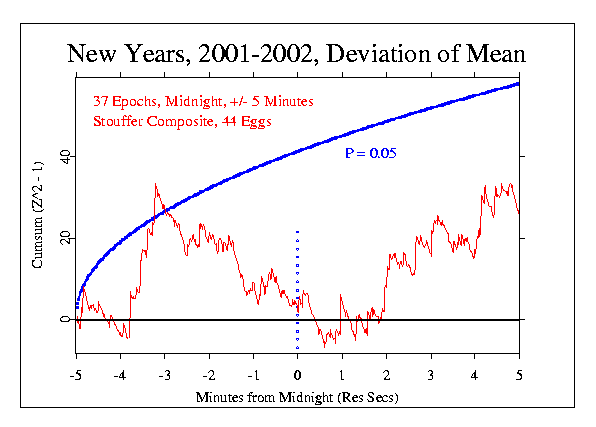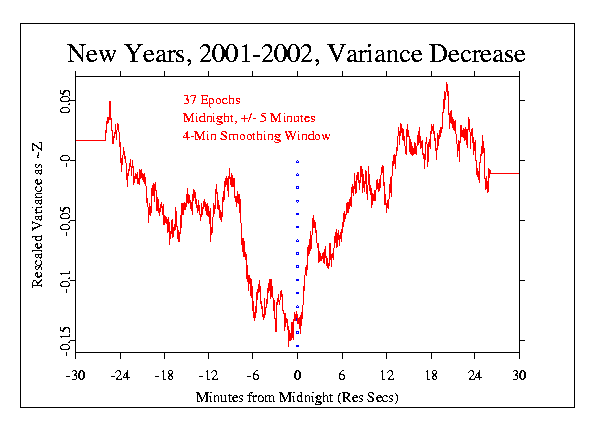|
The primary analyses for New Years 2001-2002 are complete as
of January 4th, 2002. All of the current array of active eggs have
reported as of this date, with 44 eggs archived on December 31 and on
January 1.
The formal analyses are based on the fully detailed data, with
1-second resolution. Although a few eggs are not synchronized to the
second, their mis-synchronization has only a conservative influence, so
all eggs are included in the analyses.
The composite across timezones specified in last year's analysis is used
again. (The procedure for the composite is the same
as signal averaging, say, for evoked potentials.)
A simple picture of time differences around the world assumes 24
timezones, but the formal analysis is based on
37 official timezones, from -14 to +12 hours from GMT, including 10
zones with half-hour offsets.
-
The 10 minute period surrounding midnight, which corresponds to
the first of the formal predictions, shows a modest positive trend,
with Chisquare = 625.56 on 600 df, p = 0.228. There is a sharp
positive incline a few minutes before midnight, but the figure does not
differ much from the expected random walk, so we cannot claim strong
support for the GCP prediction of a significant deviation on this
measure.
The following figure shows graphically the data for the formal prediction.

-
The second of the formal predictions for New Years 2001-2002 is based on
earlier years, beginning with the prediction of reduced variance near
midnight on Y2K.
To test it, the variance across eggs was normalized as Z-scores for each
second, then plotted. (Last year the squared Z was used, but a
comparison showed that the original Z more clearly represented the
reduction. This choice requires a Bonferonni adjustment factor of two
for multiple analysis. The sequence of Z-scores was
smoothed with a running mean (moving average) using
a fairly wide window of 240 points, following the precedent of the
previous year. As in the 1999-2000 and 2000-2001 analyses,
there is quite compelling evidence for an alteration of the variance
around midnight. In the present case, as before,
the smoothed curve displays a clear reduction
of the variance (represented as rescaled Z-scores) around midnight.
The following
figure shows a one-hour period centered on the New Year celebration.
The red curve is the running mean of the normalized variance.
The smoothing window is 4 minutes wide,
and was chosen to replicate the previous year's analysis (exploration
shows that it is not the optimal window, but all windows from 1 min to
10 minutes show the same pattern of reduction.)
An estimate for the likelihood of the apparent structure cannot readily
be made on the basis of theoretical expectations, so a permutation
procedure was used.
The original data represent a superimposition that
yields an average for each second across the 37 timezones (signal averaging).
The 60 minutes centered on midnight comprises 3600 datapoints.
To estimate the likelihood of the variance reduction at midnight,
the signal averaged data
were randomly permuted 10000 times. The figure shows the
original or "true" data in red.
There were 73 cases in the distribution of random permutations
where the minimum
variance was closer to midnight than the original data, corresponding to
a probability of p = 0.0073.
Another permutation analysis to estimate the frequency of this
degree of variance reduction at midnight found that
in 10000 cases, almost 1 in 10 (p = 0.129)
had a more extreme reduction somewhere in the hour long period
surrounding midnight. When the measures of proxmity and degree are
combined, the resulting probability is 0.00094, or less than 1 in 1000.
Because our prediction was not directional, and Z was used instead of Z²
as a selective choice, this must
be multiplied by a factor of 4, yielding p = 0.00376.

To examine the difference made by the smoothing window size, several
others were explored. All showed a tendency to focus on midnight, and
some were even more impressive than that specified for the formal test.
The next figure shows the data processed with a 5-minute window.
This informal exploration presents a quite striking picture compared
with the formally specified 4-minute window, and would have yielded a
much more extreme probability.

The feeling of exhuberence that seems nearly universal for the
New Year transition was surely damped by the too-recent events of
September 11, and the continuing troubles around the world. Many people
candidly admitted they simply did not feel like celebrating.
Nevertheless, though the outcome of the GCP analyses is not hugely
significant, the two pre-planned tests of the hypothesis do have
positive results, and that for the variance change around midnight is
impressive. The variance graphs in particular
indicate a substantial departure from expectation, focused rather
precisely around midnight.
|